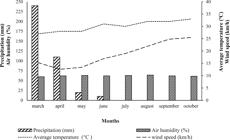ABSTRACT
This study aimed to evaluate the physiological parameters, the productive characteristics, structural and chemical composition of Urochloa Brizantha cultivars BRS and BRS Piatã submitted to two deferment periods and three using times. The experimental design was randomized complete block design in a factorial scheme 2 x 2 x 3, being two grass cultivars (Paiaguás grass and Piatã grass), two deferment periods (rainy season and dry-rainy transition) and three sealing times (40, 80 and 120 days). It was observed that, in the rainy season, the grasses had higher leaf transpiration rate when used for 40 days of deferment (1.66 µmol m2/s). During the rainy season, the Stomatal conductance was detected only in the grasses used with shorter seal, with an average of 0.07 µmol m2/s. In contrast, in the period of transition, the concentration decreased to 0.02 µmol m2/s. In a general way, the BRS Paiaguás presented lower content of NDF. The shorter cycle provided greater biomass production of total forage during the period of rain, approximately 2.78 times more than the same pasture grass deferred during the transition period. Generally, the periods of deferment and moments of use cause effects on structural characteristics of pasture, being that the period of deferment of the transition period and used for 40 and 80 days may be a strategy for keeping animals in critical periods.
Keywords:
Forage accumulation; tipping index; leaf photosynthesis rate; Urochloa brizantha

 Thumbnail
Thumbnail
 Thumbnail
Thumbnail
 Thumbnail
Thumbnail
 Thumbnail
Thumbnail



